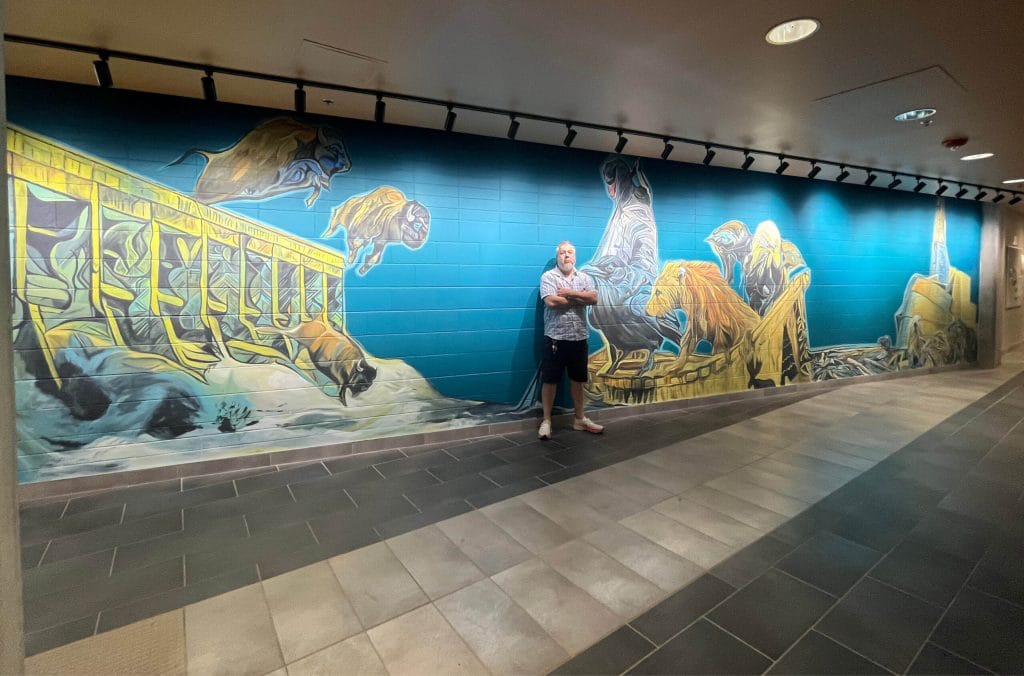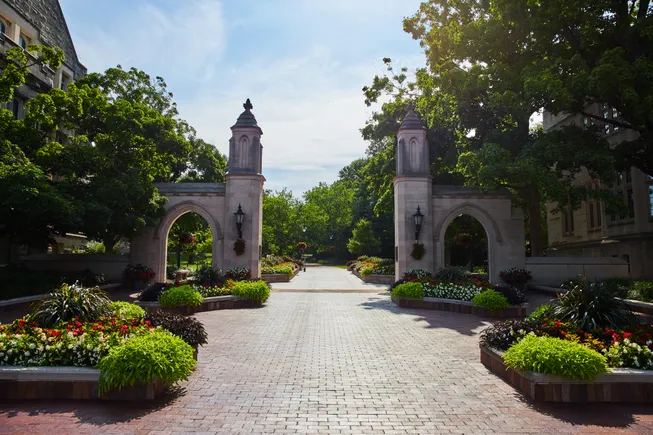
On a mural inside the University of Manitoba’s Price Faculty of Engineering, bison jump over a hydroelectric dam, plummeting into the turbulent waters below. At the base of the dam, an Indigenous fisherman stands in a canoe, surrounded by a bear, an eagle, and a crow wearing an iron engineer’s ring.
The 12-metre-long scene was painted by Winnipeg artist Mike Valcourt, who is well known for his murals around the city. Based on the theme of truth and reconciliation, the mural emphasizes the reclamation of Indigenous knowledge in engineering. The canoe is an iconic accomplishment of First Nations naval architecture, while Métis and First Nations horsemen famously engineered barriers that funnelled herds of bison toward a cliff as a hunting strategy.
“I try to create channels of dialogue between my art and the viewer,” says Mr. Valcourt, who is Métis and lists Daphne Odjig, Norval Morrisseau and Jackson Beardy among his artistic influences.
The idea for a mural originated with a comment made at an Engineers Canada panel by Randy Herrmann, director of the university’s Engineering Access Program (ENGAP), which supports Indigenous students.
“I said, ‘We need to decolonize now,’” explains Mr. Herrmann, a professional engineer and member of the Red River Métis Nation.
Spaces matter in decolonizing, says Mr. Herrmann, and he wanted “something that might make the building look like it’s part of an Indigenous cultural space,” yet without forcing the art into a cultural pigeonhole.
“We have some subconscious cultural ideas about what Indigenous art looks like,” says Dean of Engineering Marcia Friesen. “I said: ‘I just want to give space for an Indigenous artist.’”
Associate professor of engineering Jillian Seniuk Cicek chaired the mural commission committee, which chose Mr. Valcourt after meeting with several artists. Mr. Valcourt is well known for his many murals around Winnipeg.
Indigenous Manitobans make up 18 per cent of the province’s population according to the 2021 census, the highest proportion of any province in Canada (the percentage is higher in the three northern territories). Meanwhile, fewer than one per cent of Canadian engineers are Indigenous, according to a 2019 study by Engineers Canada. To encourage more Indigenous participation, the ENGAP program provides First Nations, Métis and Inuit engineering students with academic, social, financial and personal support.
“We’ve had students come who’ve left their home communities to come to Winnipeg, some of them for the first time ever living in a big city, leaving all family connections and friends behind to try to be successful here,” says Mr. Herrmann.
The program hosts an Elder-in-residence, offers upgrading courses in physics, math and chemistry, and provides career networking opportunities. ENGAP had 83 students in the 2024-25 academic year and has graduated 167 Indigenous engineers. Many are mature students or are the first in their families to attend university.
Ella Morris, an Indigenous scholar from the Red River Métis Nation and PhD candidate in engineering, says ENGAP was crucial during her undergraduate degree.
“It was really important having ENGAP there not only to cheer me on but to know, if I had any hiccups, that I had people that weren’t judgemental that I could go to and get the help I needed.”
In the winter 2024 term, Ms. Morris taught an elective course, Decolonizing and Indigenizing Engineering, along with Dr. Seniuk Cicek. Students examined the impact of engineering on Indigenous communities through critical reflection and land-based learning, which aimed to equip them to work with Métis, Inuit and First Nations.
Dr. Friesen notes that engineering projects like hydroelectric dams and oil wells have historically taken place without Indigenous consultation or consent. Although that is beginning to change, these projects remain contentious and may be supported by some Indigenous communities but not by others. Still, Dr. Friesen points out that engineering is also critical for ensuring energy independence and infrastructure development in Indigenous communities.
People sometimes assume that engineering “is separate from the work of truth and reconciliation,” says Ms. Morris.
“For me, it’s clear. I see the connection; I see that engineering does have a huge part in truth and reconciliation. It’s just [about] figuring out how to get others to see that.”







